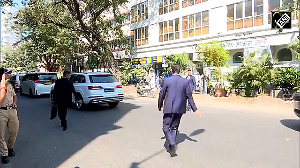A journalist working for an American newspaper asked: "Why has the Taliban attacked the Inter Services Intelligence? Isn't that like biting the hand that feeds?"
This question was in pursuance of the commando-style attack at Lahore on May 27, which targeted the Lahore police and the local ISI office, killing 15 police officers, one Lieutenant Colonel of the ISI and 10 other persons.
While analysing the Lahore attack, one has to keep in mind certain ground realities. There are virtually as many Taliban in the Pashtun belt as there are tribal sirdars (leaders). The second ground reality is the clear distinction in behaviour and operations between the Neo-Taliban of Afghanistan headed Mullah Mohammad Omar, based in Quetta, and the various Pakistani Taliban led by tribal sirdars such as Baitullah Mehsud of South Waziristan, Hakemullah Mehsud, who is responsible for operations in the Khyber, Kurrum and Orakzai areas, Maulana Fazlullah of the Tehrik-e-Nifaz-e-Shariat-e-Mohammadi, who is a son of the Swat soil, and Sufi Mohammad, his father-in-law, who is actually from Dir and not Swat.
Of these various Taliban factions, only the Neo-Taliban, which was created by the ISI in 1994 when Benazir Bhutto was the prime minister, still owes its loyalty to the ISI and the Pakistan government. The Neo Taliban is active against the US-led NATO forces in Afghan territory from sanctuaries in Pakistan, but it has never been involved in an act of terrorism in Pakistani territory against Pakistani targets -- whether from the army or the ISI or the police.
All the attacks in Pakistani territory on Pakistani government targets were carried out by different Pakistani Taliban groups or by the Jaish-e-Mohammad, which has shifted its headquarters from Bahawalpur to Swat, and the Lashkar-e-Jhangvi, an anti-Shia terrorist organisation.
The third ground reality is the distinction between the Pakistani Punjabi Taliban and the Pakistani Pashtun Taliban. All of them advocate the same Wahabised Islamic ideology based on the Sharia, but their ethnic composition differs. The term Punjabi Taliban is used to refer to the Harkat-ul-Mujahideen, the Harkat-ul-Jihad-al-Islami, the Lashkar-Tayiba, the Jaish-e-Mohammad and the LEJ. Punjabis constitute the majority of their cadres. All of them except the JEM are of the 1980s/1990s vintage. The JEM was born in 2000 through a split in the HUM. Of these organisations, the LET, like the Neo-Taliban, is the favoured tool of the ISI, which uses the Neo-Taliban in Afghanistan and the LET against India. Like the Neo-Taliban, the LET too has never attacked a Pakistani target in Pakistani territory. In fact, there has never been a confirmed instance of an attack by the LET on foreign targets in Pakistani territory lest it create problems from the ISI. The JEM and the LEJ never hesitate to attack Pakistani government targets, either on their own or at the instance of Al Qaeda. The attitude of the HUM and the HUJI is ambivalent.
The fourth ground reality is that while the Pakistani Punjabi Taliban and the Neo-Taliban have been in existence for over a decade, the Pakistani Pashtun Taliban is a product of the commando raid into the Lal Masjid in Islamabad in July,2007, in which a large number of Pashtun tribal children, many of them girls, were killed. It was after this that tribal sirdars such Fazlullah, Baitullah and Hakeemullah called for a jihad against the Pakistan Army and the ISI in retaliation for the raid.
While the TNSM has been in existence since the early 1990s, the Tehrik-e-Taliban Pakistan came into existence after the Lal Masjid raid.
The various tribal sirdars, who are supporting the TTP, repeatedly make the following points: Firstly, they did not want to fight against the Pakistan Army. It was the army which forced them to take to arms against it by raiding the Lal Masjid and killing their children. Secondly, their real enemy is the US-led NATO forces in Afghanistan and not the Pakistan Army. They are fighting against the Pakistan Army because it prevents them from assisting the Neo-Taliban against the US-led NATO forces. Thirdly, they will stop fighting the Pakistan Army if it makes amends for the alleged massacre of tribal children at the Lal Masjid, removes restrictions on their going into Afghanistan to fight against the US-led NATO troops and stops assisting the US-led NATO troops in their war against the Neo-Taliban.
The Pakistan Army is facing difficulties in its operations against the various Pakistani Pashtun Taliban groups because they have many Pashtun ex-servicemen assisting them --retired officers as well as other ranks. The attack by the Pakistani Taliban against the ISI at Lahore was not its first attack against the ISI. It had attacked the ISI twice before in Islamabad/Rawalpindi, inflicting even heavier casualties than it was able to do in Lahore.





